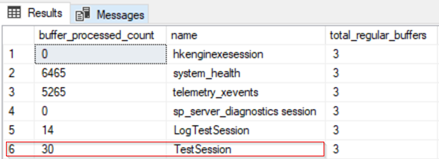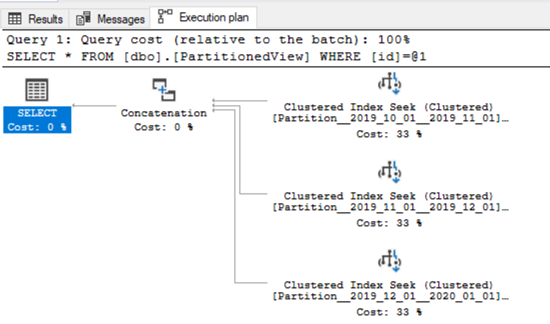MAX_DISPATCH_LATENCY as extended event session property – Specifies the amount of time that events are buffered in memory before being dispatched to event session targets. States in MSDN see link https://bit.ly/33He9Zt. The default for this value for this option is 30 seconds, and when you set it to 0 buffers are flushed to targets when they are full, or session is closed.
Let’s make a test, how we can check this behaviour. Here you can check in buffer_processed_count attribute how many times were buffer flushed to target. Let’s go to prove this behaviour.
Summary:
-
Let’s start extended events session and configure it for with max_dispatch_latency 1 seconds, I will use Ring Buffer as the target
-
There will be running script for 30 seconds and each second there will be raised user message to the system
-
With above mentioned configuration we will find 30 in buffer_processed_count because buffer is flushed each 1 second so it will be called 30 times
-
Clear session, create it again with changed configuration for max_dispatch_latency 30 seconds
-
Now you should see 1 in buffer_processed_count buffer is flushed each 30 seconds, our script runs for 30 seconds, there it comes with 1
-
Buffer is flushed to target when user calls
Query to get buffer_processed_count bellow
SELECT s.buffer_processed_count,s.name,s.total_regular_buffers,s.regular_buffer_size,s.total_large_buffers,s.large_buffer_size,s.dropped_event_count,s.dropped_buffer_count,ss.largest_event_dropped_size FROM sys.dm_xe_sessions AS s;
Script bellow lasts 30 seconds and each second there is raised user message.
DECLARE @Message VARCHAR(100)
DECLARE @i INT = 0
DECLARE @sql VARCHAR(30)=''
WHILE @i <30
BEGIn
SET @sql= 'SELECT ' + CAST (@i AS VARCHAR(20))
SET @Message='Hello '+ CAST (@i AS VARCHAR(20) )+' '+CONVERT(VARCHAR(20),GETDATE(),120)
RAISERROR( @Message,1,1);
EXEC (@sql)
WAITFOR DELAY '00:00:01'
SET @i=@i+1
END
Let’s start session.
CREATE EVENT SESSION TestSession ON SERVER ADD EVENT sqlserver.error_reported ( ACTION (sqlserver.sql_text, sqlserver.tsql_stack, sqlserver.database_id,sqlserver.username) WHERE sqlserver.database_id = 21 AND [error_number]=50000 ) ADD TARGET package0.ring_buffer (SET max_memory = 4096 ) WITH (max_dispatch_latency =1 seconds) ALTER EVENT SESSION TestSession ON SERVER STATE = START
Here you can see that target was accessed 30 times.

Clean the session
IF EXISTS (SELECT NULL FROM sys.server_event_sessions WHERE name = 'TestSession') BEGIN DROP EVENT SESSION TestSession ON SERVER; END
Run it again with changed attribute max_dispatch_latency =30 seconds. Bellow you can see that target was accessed only 1 time.

Beware of that the counter changes in cases you access targets manually with script bellow.
IF OBJECT_ID('tempdb.dbo.#LogData') IS NOT NULL
DROP TABLE #LogData;
SELECT CAST(LocksAcquired.TargetXml AS XML) AS XMLData
INTO #LogData
FROM (SELECT CAST(t.target_data AS XML) AS TargetXml
FROM sys.dm_xe_session_targets AS t
JOIN sys.dm_xe_sessions AS s ON s.address = t.event_session_address
WHERE s.name='TestSession'
) AS LocksAcquired;
SELECT T.XMLData.value('(action[@name="sql_text"])[1]', 'varchar(1000)' ) AS [SqlText],
T.XMLData.value('(@timestamp)[1]', 'datetime' )AS [OccurredDtTm],
T.XMLData.value('(data[@name="message"])[1]','varchar(60)' ) AS [Message]
FROM #LogData CROSS APPLY XMLData.nodes('/RingBufferTarget/event[@name="error_reported"]') AS T(XMLData);


